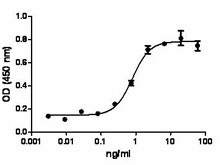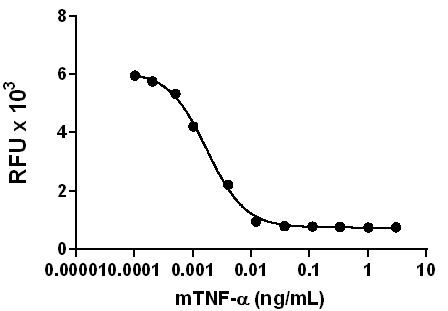- Regulatory Status
- RUO
- Other Names
- Cytotoxic T-lymphocyte-associated antigen 8, cytotoxic T-lymphocyte-associated serine esterase 8, Ctla8, Ctla-8, Il17a, Il17
- Ave. Rating
- Submit a Review
- Product Citations
- 12 publications
| Cat # | Size | Price | Save |
|---|---|---|---|
| 576002 | 10 µg | ¥29,260 | |
| 576004 | 25 µg | ¥52,740 | |
| 576006 | 100 µg | ¥116,620 | |
| 576008 | 500 µg | ¥349,850 |
IL-17A was initially identified from a subtracted cDNA library between closely related murine lymphoid cells and called CTLA-8. IL-17A shares 58% homology with an open reading frame of the T-lymphotropic Herpes virus Samirii virus (viral IL-17). IL-17A belongs to a family of cytokines, which has five members; designated IL-17A-F. IL-17 is expressed by a unique lineage of CD4 T cells, Th17 cells. This lineage selectively produces proinflammatory cytokines including IL-17, IL-17F, IL-21, and IL-22. In the mouse, the differentiation of this new lineage is initiated by TGFbeta-1 and IL-6 or IL-21, which activates Stat3 and induces the expression of the transcription factor retinoic acid-related orphan receptors (RORγt and RORα). IL-23, which also activates Stat3, serves to maintain Th17 cells lineage.
Product DetailsProduct Details
- Source
- Mouse IL-17A, amino acids Ala26-Ala158 (Accession # NM_010552) was expressed in E. coli.
- Molecular Mass
- The 133 amino acid recombinant protein has a predicted molecular mass of 14,978 Da. This protein exists as a disulfide-linked homodimer. The DTT-reduced protein migrates at approximately 15kDa by SDS-PAGE. The non-reduced protein migrates as a homodimer, at approximately 28kDa by SDS-PAGE.
- Purity
- Purity is >98%, as determined by Coomassie stained SDS-PAGE.
- Formulation
- 0.22 µm filtered protein solution is in 10 mM NaH2PO4, 0.15 M NaCl, pH 7.2.
- Endotoxin Level
- Endotoxin level is <0.1 EU/µg (<0.01 ng/µg) protein as determined by the LAL method.
- Concentration
- 10 and 25 µg sizes are bottled at 200 µg/mL. 100 µg size and larger sizes are lot-specific and bottled at the concentration indicated on the vial. To obtain lot-specific concentration and expiration, please enter the lot number in our Certificate of Analysis online tool.
- Storage & Handling
- Unopened vial can be stored between 2°C and 8°C for up to 2 weeks, at -20°C for up to six months, or at -70°C or colder until the expiration date. For maximum results, quick spin vial prior to opening. The protein can be aliquoted and stored at -20°C or colder. Stock solutions can also be prepared at 50 - 100 µg/mL in appropriate sterile buffer, carrier protein such as 0.2 - 1% BSA or HSA can be added when preparing the stock solution. Aliquots can be stored between 2°C and 8°C for up to one week and stored at -20°C or colder for up to 3 months. Avoid repeated freeze/thaw cycles.
- Activity
- The ED50 is 0.25 - 1 ng/ml, corresponding to a specific activity 1.0 - 4 x 106 units/mg, as determined by a dose dependent stimulation of fetal mouse skin fibroblasts production of IL-6.
- Application
-
Bioassay
- Recommended Usage
-
Use when high specific biological activity is required.
- Application Notes
-
BioLegend carrier-free recombinant proteins provided in liquid format are shipped on blue-ice. Our comparison testing data indicates that when handled and stored as recommended, the liquid format has equal or better stability and shelf-life compared to commercially available lyophilized proteins after reconstitution. Our liquid proteins are verified in-house to maintain activity after shipping on blue ice and are backed by our 100% satisfaction guarantee. If you have any concerns, contact us at tech@biolegend.com.
- Additional Product Notes
-
View more applications data for this product in our Scientific Poster Library.
-
Application References
(PubMed link indicates BioLegend citation) - Product Citations
-
Antigen Details
- Structure
- Cytokine
- Distribution
-
IL-17A is largely produced by activated memory T lymphocytes, CD4+ T helper cells (Th17), neutrophils, CD8(+), NK, and gamma-delta T cells. IL-17AR is expressed in epithelial cells, fibroblasts, B and T lymphocytes, myelomonocytic cells, and marrow stromal cells.
- Function
- IL-17A is a potent regulator of granulopoiesis and neutrophil recruitment under normal and inflammatory conditions. Organ overexpression of IL-17A increases circulating neutrophil numbers and recruitment into the organs by induction of CXCL2, IL-1β, and G-CSF. IL-17A induces CXCL1, CXCL2, CXCL5, and CXCL8 in human epithelial cells. IL-17A also cooperates with TLR ligands, IL-1 beta, and TNF alpha to enhance inflammatory reactions and stimulate production of beta-defensins and other antimicrobial peptides. Th17 differentiation of human and murine naïve T cells is markedly suppressed in the presence of IFNα.
- Bioactivity
- IL-17A signals through a heteromeric receptor composed of IL-17RA and IL-17RC.
- Biology Area
- Cell Biology, Immunology, Neuroinflammation, Neuroscience
- Molecular Family
- Cytokines/Chemokines
- Antigen References
-
1. Yu J, et al. Front Biosci 13:170-177 2008.
2. Toy D, et al. J. Immunol. 177:36-39 2006.
3. Benghiat FS, et al. Transplant Rev 23:11-18 2009.
4. Honorati MC, et al. Rheumatology 40:522-527 2001.
5. Rouvier E, et al. J. Immunol. 150:5445-5456 1993.
6. Liang SC, et al. J. Immunol. 179:7791-7799 2007.
7. Ouyang W, et al. Immunity 28:454-467 2008. - Gene ID
- 16171 View all products for this Gene ID
- UniProt
- View information about IL-17A on UniProt.org
Related FAQs
- Why choose BioLegend recombinant proteins?
-
• Each lot of product is quality-tested for bioactivity as indicated on the data sheet.
• Greater than 95% Purity or higher, tested on every lot of product.
• 100% Satisfaction Guarantee for quality performance, stability, and consistency.
• Ready-to-use liquid format saves time and reduces challenges associated with reconstitution.
• Bulk and customization available. Contact us.
• Learn more about our Recombinant Proteins. - How does the activity of your recombinant proteins compare to competitors?
-
We quality control each and every lot of recombinant protein. Not only do we check its bioactivity, but we also compare it against other commercially available recombinant proteins. We make sure each recombinant protein’s activity is at least as good as or better than the competition’s. In order to provide you with the best possible product, we ensure that our testing process is rigorous and thorough. If you’re curious and eager to make the switch to BioLegend recombinants, contact your sales representative today!
- What is the specific activity or ED50 of my recombinant protein?
-
The specific activity range of the protein is indicated on the product datasheets. Because the exact activity values on a per unit basis can largely fluctuate depending on a number of factors, including the nature of the assay, cell density, age of cells/passage number, culture media used, and end user technique, the specific activity is best defined as a range and we guarantee the specific activity of all our lots will be within the range indicated on the datasheet. Please note this only applies to recombinants labeled for use in bioassays. ELISA standard recombinant proteins are not recommended for bioassay usage as they are not tested for these applications.
- Have your recombinants been tested for stability?
-
Our testing shows that the recombinant proteins are able to withstand room temperature for a week without losing activity. In addition the recombinant proteins were also found to withstand four cycles of freeze and thaw without losing activity.
- Does specific activity of a recombinant protein vary between lots?
-
Specific activity will vary for each lot and for the type of experiment that is done to validate it, but all passed lots will have activity within the established ED50 range for the product and we guarantee that our products will have lot-to-lot consistency. Please conduct an experiment-specific validation to find the optimal ED50 for your system.
- How do you convert activity as an ED50 in ng/ml to a specific activity in Units/mg?
-
Use formula Specific activity (Units/mg) = 10^6/ ED50 (ng/mL)





















Follow Us